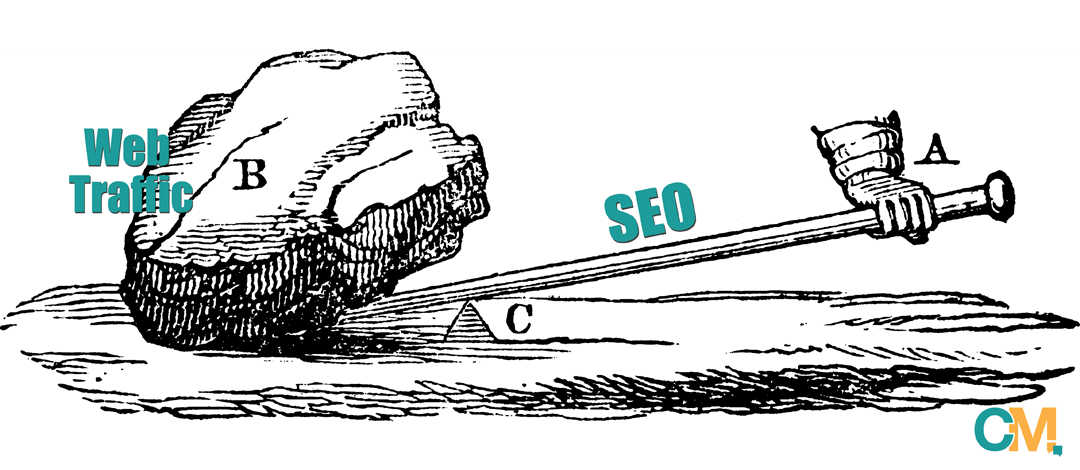
10 Ways to Leverage Search Engine Optimization to Improve Organic Web Traffic
Suppose you’ve been staring at your analytics dashboard, desperately hoping for a miracle spike in organic (unpaid) traffic. In that case, I’m here to tell you it’s not going to happen—at least not without a bit of search engine optimization (SEO) work on your part.
A well-optimized website is essential for driving organic traffic and attracting potential customers, and SEO is the way to improve your website’s visibility in search engine results pages (SERPs).
If you use the right strategies, you can make your website work better for you. And if you implement the following ten strategies, you will maximize your SEO and your online presence to attract more visitors to your website.
1. Be a Keyword Detective

Keywords unlock the doors of search engine success. Think of yourself as a detective hunting for clues you can find within your target audience. What are their busy fingers typing into search engines? Uncover what your best customer prospects are looking for, and you’ve solved the case. Tools like Google Keyword Planner, SEMrush, and Moz Keyword Explorer can help you discover valuable keywords with high search volumes and low competition or niche keywords with high customer intent.
2. It’s So Meta
Optimizing your on-page elements, including page titles, meta descriptions, alt-text, and URLs, is vital to search engine optimization success. They may live behind the scenes, but they’re very much front and center when it comes to visibility and user satisfaction. They allow search engine crawlers to understand what your website is about, and when crawlers understand your website, it makes it easier for search engines to match your page with the most relevant queries so the SERPs show users the best results. Make sure to include valuable keywords to rank better and improve user experience.
3. Be upwardly Mobile
In the last few years, mobile optimization went from nice-to-have to must-have. Depending on whom you want to believe, the average American looks at their phone between 96 and 150 a day or more. The fact is that mobile web traffic has surpassed desktop traffic in the last few years, so if you haven’t optimized your website for mobile, you might as well be selling buggy whips while self-driving cars become the norm. Your website must be responsive, wicked fast and offer a seamless browsing experience across different devices. Test your website’s mobile-friendliness using Google’s Mobile-Friendly Test.
4. Get Social with Social Media

It’s a myth that social media signals directly impact search ranking; the truth is they indirectly affect it by increasing brand visibility and driving traffic to your website. When your website gets traffic, it raises your site’s cool factor with search engines; as you rank higher in search engine results pages, your website gets more traffic. As your website gets more traffic, search engines like your website better. It’s a beautiful thing.
5. Quality is Queen
Yeah, yeah, yeah. We’ve all heard the old saw, “Content is king,” but quality is queen, and relevance is the prince or princess. Quantity is the frog in this scenario; without quality and relevance, it will never become royalty. When you educate, engage and entertain visitors; they will stay longer, share more and return more often. Try creating longer-form content, such as high-quality, 1,000+-word blog posts or comprehensive guides; they tend to perform better in search rankings.
6. Use Your Inside Voice
With the popularity of voice assistants like Siri and Alexa, voice search is becoming increasingly important for SEO. According to TechJury, 40% of all internet searches in the US are voice-based, so be sure to include conversational keywords and answers to frequently asked questions when optimizing content and refining SEO. Keep in mind that short, direct answers are more manageable for voice assistants to serve results to users.
7. Avoid the Weakest Backlinks
Backlinks are like votes in a popularity contest. The more you get, the more popular you are and the better your reputation. When reputable and authoritative sites link to your content, it improves your SEO by giving your site the seal of approval. Keep in mind, however, that links from shady sites or black-hat link farms have the opposite SEO effect: they’ll sink your site like an iceberg in front of the Titanic.
8. The Need for Speed
Website speed is a critical factor for user experience and search engine ranking because, in an era where most people have the attention span of a goldfish, nobody wants to wait. Google says the probability of bounce almost triples if your page takes longer than three seconds to load, and if people bounce, you can kiss conversions goodbye. Ways to speed things up include compressing images, minifying CSS and JavaScript files, and utilizing caching mechanisms. Tools like Google PageSpeed Insights can help identify issues and provide tips for improving your website’s speed.
9. Google My Business, Please
Optimizing Google My Business, now known as Google Business Profile, is an essential step, no matter what you call it, especially for local SEO. Among other benefits, a Google Business Profile will help you appear in local search results. So, if you haven’t already, claim your business, fill out your profile information, upload photos, post consistently, and encourage (and respond to) customer reviews.
10. Analyze, Adjust, Rinse and Repeat
SEO is the carnival ride that never ends. You go up, and you go down, you go round and round, then you start all over again. The importance of analyzing your website results can’t be understated, so set a goal and regularly measure essential key performance indicators (KPIs) to help understand whether you are making progress toward your goal. You can use tools like Google Analytics and Google Search Console to track your organic traffic, keyword rankings, and user behavior, identify areas for improvement and adjust your strategies to improve results continually.
Implementing these ten effective SEO strategies will help you boost your website’s organic traffic and improve its visibility in search engine rankings. Remember, SEO is an ongoing process, and algorithms change, so it’s vital to stay updated with the latest trends and adapt accordingly.





Recent Comments